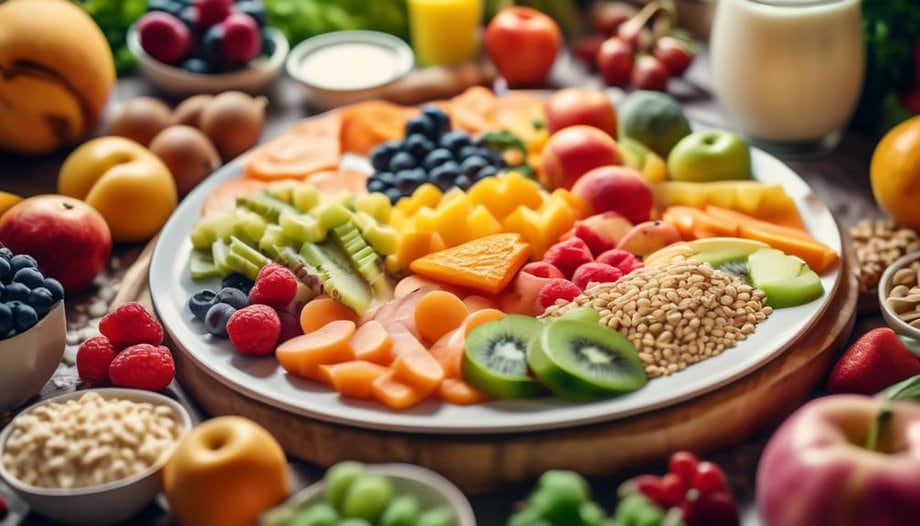How to Plan Balanced Meals for Growing Children

Planning balanced meals for growing children is essential for their overall health and development. Here are some tips to help you create nutritious and well-rounded meals for your kids:
- Include a variety of food groups: Make sure to include foods from all the major food groups – fruits, vegetables, whole grains, lean proteins, and dairy products. This ensures that your child gets a wide range of essential nutrients.
- Serve appropriate portion sizes: It's important to serve appropriate portion sizes for your child's age and activity level. Avoid overfeeding or underfeeding them, as both can have negative effects on their growth and health.
- Limit processed foods and added sugars: Processed foods and those high in added sugars can be detrimental to your child's health. Instead, opt for whole, unprocessed foods as much as possible. Limit sugary drinks and snacks, and opt for healthier alternatives like water, milk, or homemade fruit smoothies.
- Involve your child in meal planning: Engage your child in the meal planning process to make them more inclined to try new foods. Let them choose fruits and vegetables they like, and involve them in cooking and preparing meals. This will help develop their interest in healthy eating and make mealtime more enjoyable.
- Offer a variety of flavors and textures: Introduce a wide range of flavors and textures to your child's meals. This will help expand their palate and make them more open to trying new foods. Don't be discouraged if they initially reject certain foods – continue offering them in different ways, as taste preferences can change over time.
- Be mindful of food allergies and intolerances: If your child has any food allergies or intolerances, make sure to plan meals accordingly. Substitute ingredients or find suitable alternatives to ensure they still receive all the necessary nutrients without compromising their health.
Remember, a balanced diet is a key component of your child's growth and development. By following these tips and being mindful of their nutritional needs, you can help your child thrive and establish healthy eating habits for life.
Food Groups and Portions
To ensure a balanced and nutritious diet for growing children, it's important to understand the different food groups and the appropriate portions to include in their meals. By dividing their plate, you can ensure that half of it's filled with colorful vegetables and fruits, while the other half consists of whole grains and healthy protein. This provides a variety of nutrients needed for their healthy growth.
Including a variety of fruits and vegetables in their meals and snacks is crucial. This ensures that they receive a wide range of vitamins and minerals essential for their development. Encourage your children to try different types of fruits and vegetables to keep their meals exciting and nutritious.
When it comes to dairy foods, they're needed in smaller amounts compared to other foods on the plate. Choose unflavored milk, plain yogurt, and small amounts of cheese to provide them with the necessary calcium and other nutrients they need for strong bones and teeth.
Offering water with every meal and snack is important to keep your children hydrated. Limit juice to one small glass per day and avoid sugary drinks like sodas and fruit drinks, as they can contribute to excessive calorie intake and dental issues.
It is also important to introduce foods other than breast milk and infant formula at around 6 months old. This is the time when your child's nutrient needs increase, and a variety of vitamins and minerals are needed for their healthy growth.
Incorporating Nutrient-Rich Foods
When it comes to providing balanced meals for growing children, incorporating nutrient-rich foods is essential for their overall health and development. By including a variety of whole grains, fruits and vegetables, and low-fat dairy products in their diet, you can ensure that they're getting enough vitamins, minerals, and other essential nutrients.
Here are some practical tips to help you incorporate these healthy foods into your child's meals:
- Opt for whole grains: Choose whole grain bread, pasta, and cereals instead of refined grains to provide fiber, vitamins, and minerals. Whole grains are an important source of energy and help support your child's growth and development.
- Include plenty of fruits and vegetables: Aim to include a variety of colorful fruits and vegetables in your child's meals and snacks. These nutrient powerhouses provide essential vitamins and minerals, as well as fiber, which is important for digestion and overall health.
- Encourage low-fat dairy products: Milk, yogurt, and cheese are excellent sources of calcium, which is crucial for growing children. Opt for low-fat or fat-free options to limit unhealthy saturated fats while still providing the necessary nutrients for strong bones and teeth.
Planning Meals for Growth and Development
When planning meals for your growing child, it's important to focus on nutrient-rich options that support their growth and development.
Choose foods that are high in vitamins, minerals, and protein to provide the essential nutrients they need.
Additionally, pay attention to portion sizes to ensure that your child is getting the right amount of food for their age and activity level.
Nutrient-Rich Meal Options
Including a variety of nutrient-rich foods in your child's meals is essential for optimal growth and development. When planning meals for your child, make sure to incorporate a variety of fruits and vegetables. These provide a wide range of vitamins and minerals that are important for their overall health.
Opt for whole grains, such as whole wheat bread or brown rice, and healthy protein options like lean meat or beans to balance their plate. For dairy options, choose unflavored milk, plain yogurt, or small amounts of cheese.
To promote balanced nutrition throughout the day, pack healthy snacks like nuts, seeds, or yogurt in your child's lunchbox. And remember, encourage your child to consume whole fruits or sliced fruits instead of fruit juices to get the most nutritional benefits.
Portion Sizes for Kids
To ensure balanced meals for your growing child, it's important to consider portion sizes that are appropriate for their age, growth stage, and activity level. Providing the right amount of food is crucial for meeting their nutritional needs and promoting healthy growth and development.
Encourage your child to eat a variety of foods from all food groups, including fruits, vegetables, proteins, and starchy foods. Start with smaller portions and allow your child to ask for more if they're still hungry. As they grow, gradually increase portion sizes following nutritional guidelines.
Avoid offering foods with added sugars and opt for fresh, canned, or frozen options that are rich in vitamins and minerals. For young children, breast milk should be the main source of nutrition until the age of 1.
Balancing Macronutrients
Balancing macronutrients in your child's meals is crucial for their overall growth and development. By including a mix of carbohydrates, proteins, and fats, you can ensure they receive the necessary nutrients for optimal health.
Here are three key tips to help you achieve a balanced macronutrient intake for your children:
- Fill half of their plate with colorful vegetables and fruits. These whole foods are rich in vitamins and minerals that are essential for their growth and development. Encourage your children to eat a variety of fruits and vegetables to ensure they receive a wide range of nutrients.
- The other half of the plate should consist of whole grains and healthy protein sources. Whole grains are a great source of carbohydrates, providing energy for your children's active lifestyles. Opt for whole grain bread, pasta, and rice instead of refined grains. When it comes to protein, choose lean options such as poultry, fish, and eggs. Limit the intake of red and processed meats to promote better health.
- Don't forget about healthy fats! Include sources like nuts, seeds, and plant-based oils in your child's meals. These fats are essential for their brain development and overall health.
Sneaking in Fruits and Vegetables
Looking for creative ways to ensure your kids consume enough fruits and vegetables in their meals and snacks? Sneaking in fruits and vegetables can be an effective strategy to boost their nutritional intake without them even realizing it. By incorporating fruits and veggies into everyday dishes, you can provide your growing children with essential vitamins and minerals while promoting balanced meals.
One simple way to sneak in fruits and vegetables is by adding them to smoothies. Blend a variety of colorful vegetables like spinach or kale with sweet fruits like bananas or berries to create a delicious and nutrient-rich drink. Another option is to incorporate pureed vegetables into pasta sauces or baked goods. Your kids won't even notice the added vegetables, but they'll benefit from the extra nutrients.
You can also use fruits and vegetables as toppings or fillings in sandwiches, wraps, and quesadillas. Adding sliced tomatoes, cucumbers, or avocado can provide a burst of flavor and nutrition. Additionally, experimenting with different cooking methods like roasting, grilling, or steaming can enhance the flavors and textures of fruits and vegetables, making them more appealing to children.
Engaging your children in grocery shopping and meal preparation can also encourage their interest in fruits and vegetables. Let them choose colorful vegetables and fruits they find appealing, and involve them in the cooking process. This way, they'll be more likely to try and enjoy these nutritious foods.
Incorporating fruits and vegetables into your children's meals and snacks is essential for their growth and development. By sneaking them in creatively, you can ensure they eat a variety of colorful vegetables and fruits, helping them achieve balanced meals and receive the necessary vitamins and minerals they need.
Smart Snacking Options
For a nutritious and satisfying snack, consider incorporating fruits, vegetables, whole grains, and lean proteins into your child's snacking options. Providing a variety of these foods will ensure that your child gets the vitamins and minerals they need to support their growth and development.
Here are some smart snacking options that you can include in your child's diet:
- Fruits: Fresh or frozen fruits like berries, apples, and oranges are a great choice for a sweet and refreshing snack. They're packed with vitamins, fiber, and antioxidants, which can help boost your child's immune system and promote healthy digestion.
- Vegetables: Cut-up vegetables like carrots, cucumbers, and bell peppers make for a crunchy and nutritious snack. They're rich in vitamins and minerals, such as vitamin C and potassium, that are essential for your child's overall health.
- Whole grains: Choose whole grain options like whole wheat bread, crackers, or popcorn for a filling and fiber-rich snack. Whole grains provide sustained energy and can help your child feel satisfied between meals.
In addition to these options, incorporating lean proteins like yogurt, nuts, and seeds can make for a balanced and satisfying snack. These foods provide essential amino acids that are important for your child's growth and muscle development.
Remember to limit foods that are high in added sugars and processed ingredients, and instead opt for healthier alternatives like unsweetened dairy products and homemade snacks. Portion control is also crucial when it comes to snacking, so make sure to offer smaller, nutrient-dense portions to avoid overeating.
Lastly, encourage your child to stay hydrated by offering water as the primary beverage choice for snacks. By providing smart snacking options, you can help your child develop healthy eating habits and enjoy the benefits of eating nutritious foods.
Meal Prep Tips for Busy Parents
To save time and simplify meal preparation for busy parents, here are some practical and efficient meal prep tips.
Planning and preparing meals in advance can be a game-changer, especially during busy weekdays. By doing so, you can ensure that your child is getting the right balance of vitamins and minerals in their diet.
Opting for one-pot meals or sheet pan dinners is another great time-saving strategy. These meals require minimal cooking and clean-up, allowing you to spend more quality time with your family.
Utilizing kitchen gadgets like slow cookers, instant pots, or air fryers can also make your life easier. These products can help you prepare delicious and nutritious meals without spending hours in the kitchen.
Batch cooking and freezing portions is another smart strategy. By doing this, you can have quick and easy meals on hectic days.
Involving your children in the meal prep process not only teaches them about healthy eating but also encourages their interest in nutritious foods. This is crucial for your child's health and well-being.
Frequently Asked Questions
What Is a Balanced Diet for a Growing Child?
A balanced diet for a growing child includes essential nutrients for their growth and development. It involves portion sizes, different food groups, and meal planning tips. Snack ideas and healthy food swaps can help create a positive eating environment.
How Do You Make a Balanced Meal for Kids?
To make a balanced meal for kids, focus on meeting their nutritional requirements through portion control. Incorporate fruits and veggies, protein sources like fish or poultry, whole grains, healthy fats, and limit sugary foods. Don't forget the importance of hydration.
What Are the Best Meals for Growing Children?
For growing children, it's important to plan meals that are nutrient-packed and balanced. Incorporate fruits and vegetables, protein-rich meals, whole grain options, and hydration with water. Try quick breakfast ideas, creative lunchbox options, and healthy dinner recipes.
How Do You Keep a Balanced Diet for Kids?
To keep a balanced diet for kids, focus on their nutritional needs, control portions, and include plenty of fruits, veggies, lean protein, and whole grains. Limit added sugars, include healthy fats, promote hydration, and find a balance between treats and healthy choices.











